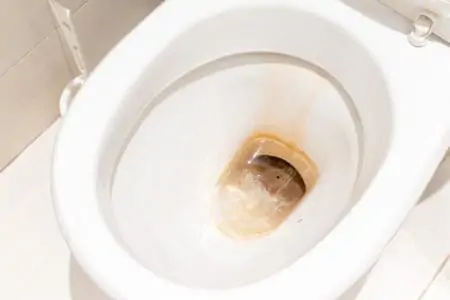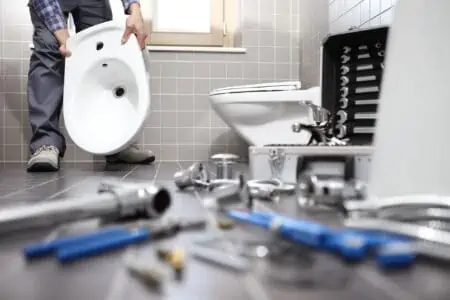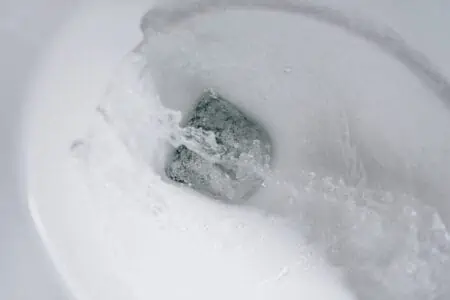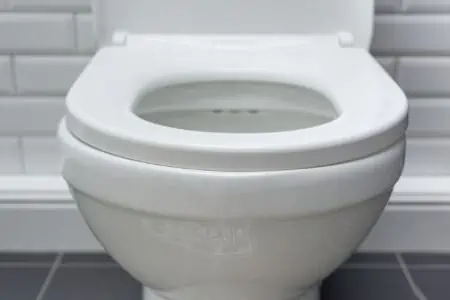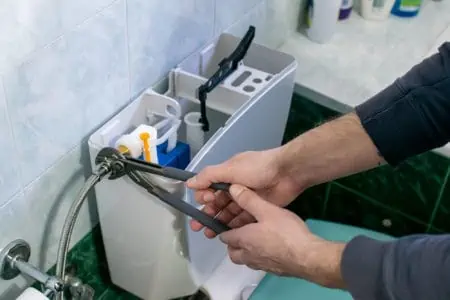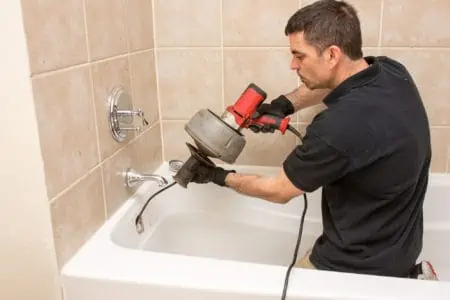If your toilet develops staining, it might not be a result of poor housekeeping. It could be hard water issues or the effects of standing water. So, what do you do? Reach for the bleach, or find alternative ways to deal with the problem?
We show you how to get rid of toilet bowl rings using the 12 best methods, some obvious and some more surprising.
Key Takeaways
- Causes of toilet bowl rings: Rusty brown rings indicate mineral deposits, green/orange streaks are from mold, and pink stains are caused by Serratia marcescens bacteria.
- Scrubbing methods: Use a combination of baking soda and vinegar, a pumice stone, borax and vinegar, or steel wool to remove stubborn toilet bowl rings.
- No-scrub methods: White vinegar, CLR (calcium, lime, and rust remover), bleach, Magic Eraser, Coca-Cola, Alka Seltzer, and denture cleaning tablets can help remove rings without scrubbing.
- Prevention tips: Use WD-40, Alka Seltzer in the water tank, or add lemon or lime to the water tank to prevent toilet bowl rings from forming.
What Causes Toilet Bowl Rings?
There are lots of different types of toilet bowl rings, but what causes them is typically depicted in their colors. A rusty brown ring is likely the cause of mineral deposits like chalk in hard water areas. These can also be black.
Calcium, magnesium, and irons are all elements found in hard water areas and the culprits that form mineral coatings on the inside of your toilet bowl. Unfortunately, chemical cleaners are not that effective on this type of staining. Instead, you may need a combination of detergent and manual labor.
If you have green, orange streaks and rings, mold is likely to be the main suspect. Bacterial stains caused by Serratia marcescens are typically pink in color and love standing water where the liquid line meets the toilet surface.
Knowing what is causing your discoloration is crucial because it helps you target the correct response to remove them.
How To Get Rid of Toilet Bowl Rings
It’s worth noting that most water rings are kept at bay using regular detergents and household products as part of your cleaning regime. However, if all else fails, it’s time to reach for the big guns.
We have listed the best methods and divided them into scrub and no-scrub techniques.
Baking Soda and Vinegar
When you combine these two common and edible elements, they create a powerful cleaning agent that works in almost every staining situation.
Add a cup of white vinegar to the toilet bowl and swish it around with a toilet brush. Sprinkle a cup of baking soda into the water, followed by another 2 cups of vinegar. This creates an immediate chemical reaction as the two mix, causing lots of fizzing. Leave for 10 minutes.
Use the toilet brush to swirl it around the toilet, making sure the solution touches the entire surface of the bowl, making sure you don’t flush the toilet.
Repeat this swishing action every now and then for the next 30 minutes. The stains should lift, but if not, grab the brush and scrub away at stubborn spots. Then flush the toilet.
Pumice Stone
Some stains are so ingrained that they are beyond the cleaning power of detergents and bleach to dissolve them. Sometimes you need some old-fashioned elbow grease. A pumice stone is an ideal solution to stubborn stains that nothing else will shift.
However, use the pumice stone with caution, as it could mark the surface of your vitreous china and leave a more unsightly scar than the staining.
Gently work the surface of the stone over the ring, taking care that you are only removing mineral content and not the glazing on the china. Rub your finger along the surface, and if it feels smooth, the stain is gone. Now flush the toilet.
Borax and Vinegar
Borax gives your vinegar a boost by increasing the cleaning power in the toilet bowl. Borax is a commonly used detergent and water softener and is an effective way of removing water rings in the toilet bowl when added to vinegar.
Sprinkle a quarter of a cup in the toilet bowl and swirl it around with a toilet brush. Next, add a cup of vinegar, allowing it to mix in the water for 20 minutes. Don some rubber gloves and scrub the stains with the toilet brush to remove stubborn marks.
Steel Wool
Steel wool is the last resort because of the damage it can do to the glazing on your vitreous china surface. If the staining is so hardened that other cleaning agents are ineffectual, you need to get physical.
Use 0000-grade steel wool as anything courser would cause even more damage to the toilet’s surface. You might get better results when you combine the steel wool with another detergent like vinegar or baking soda.
Remember
Wear protective gloves to keep your hands safe from the wire wool.
Dryer Sheets
Believe it or not, used dryer sheets are more effective than new ones. Remove as much water as possible and use the dryer sheets to wipe the bowl’s surface, removing the stain. Make sure the bowl is as dry as possible.
Remember
Don’t flush the dryer sheet down the toilet as this could lead to a blockage.
Removing Toilet Rings Without Scrubbing
White Vinegar
White vinegar is the knight in shining armor for most staining, be it hard water or bacteria. There are two ways you can use it: non-scrubbing and scrubbing methods. You can also use vinegar with another additive, like baking soda. For now, we will focus on neat white vinegar.
White vinegar is an excellent way of stopping rings from appearing by pouring a cupful into the toilet bowl once or twice a week as a preventative measure.
It won’t harm your toilet or the tank and inner workings, and it has the added benefit of deodorizing. Leave the vinegar to soak, allowing the acidic qualities to lift the grime from the inside of the bowl.
CLR
CLR, or calcium, lime, and rust remover, is the big daddy of the cleaning world. It is the enemy of hard water staining, dissolving them instantly. And the great news is it is non-toxic and safe to use, even if you have a septic tank.
Pur a capful into the toilet water and leave to work for 20 minutes. Then, grab a brush and scrub away any stubborn stains and flush the toilet.
Bleach
Bleach works best on bacteria and mold rings but is ineffectual on hard water stains. Also, if you have a septic tank with a carefully balanced ecosystem to deal with the waste, bleach upsets that balance and could lead to greater issues than staining.
The best way to use bleach is to add a couple of capfuls into the toilet, leave it for 30 minutes to an hour, and then flush. It should clean the surface, leaving it sparkling clean. Using bleach alone is less effective than using a cleaning product that contains bleach.
Magic Eraser
It may seem unconventional to use a Magic Eraser to eliminate water rings. Break a chunk off and drop it into the toilet bowl. Leave it overnight to do its work. The following morning, hook it out and flush the toilet.
Don’t flush the toilet with the eraser still in the bowl.
Coca-Cola
You will only need a single can of Coca-Cola, and any other fizzy soda may work just as well. Pour the cola into the toilet bowl and leave it for about an hour. The acids in the cola eat away at the staining, leaving you with a sparkling clean toilet.
The downside is if you leave the cola too long, it could end up staining your bowl brown, so make sure you flush it after an hour.
Alka Seltzer
Alka Seltzer is an effective way of removing water rings. Drop 2 into the toilet bowl and let them dissolve. The acid in the solution lifts the mineral deposits off the surface of the toilet.
For a longer-term solution, drop a tablet into your toilet water tank every week to stop water rings from forming.
Denture Cleaning Tablets
Denture cleaning tablets work in the same way as Alka Seltzer, except they are less harsh, which does less damage to the surface of your toilet. Simply pop one in the bowl and let it dissolve, allowing the acids to melt the water ring.
You can also pop one into your water tank to keep mineral stains at bay for more extended protection.
How To Keep a Toilet from Getting a Ring
Prevention is far better than the cure, so rather than wait until your toilet forms unsightly stains, try these tips to keep them at bay.
Use WD-40
This famous brand of lubricant is excellent at removing and preventing water rings in your toilet. A generous spray stops the rings from forming, while applying the spray directly onto a water ring and leaving it for a few minutes, lifts it clean off the surface.
Use Alka Seltzer in the Water Tank
Pop an Alka Seltzer in your water tank every couple of days to prevent water rings. It dissolves as the flush works, preventing any mineral deposits from forming on the surface of the bowl.
Add Lemon or Lime
Citrus fruit like lemon and lime has a natural acid that removes mineral water stains from toilets, so popping a cut lemon or lime in the water tank releases acids every time you flush.
It stops watermarks and deodorizes the toilet, leaving it smelling lemony-fresh.
